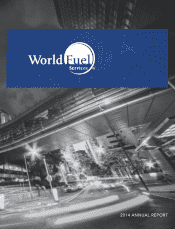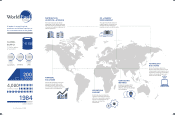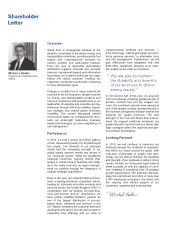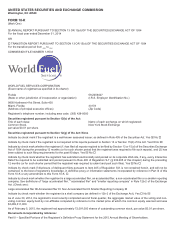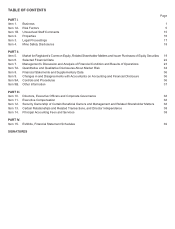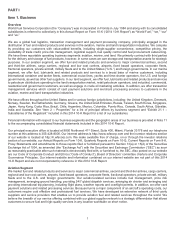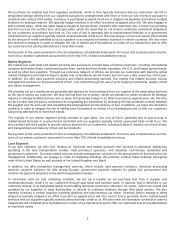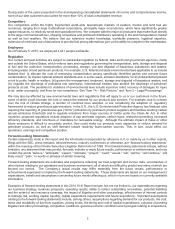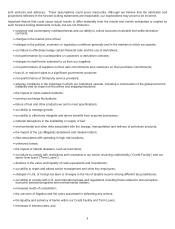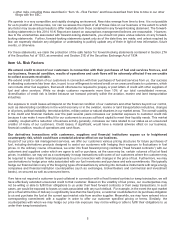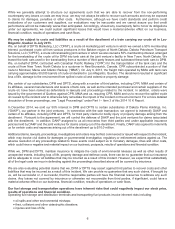World Fuel Services 2014 Annual Report Download - page 10
Download and view the complete annual report
Please find page 10 of the 2014 World Fuel Services annual report below. You can navigate through the pages in the report by either clicking on the pages listed below, or by using the keyword search tool below to find specific information within the annual report.5
• other risks, including those described in “Item 1A - Risk Factors” and those described from time to time in our other
filings with the SEC.
We operate in a very competitive and rapidly changing environment. New risks emerge from time to time. It is not possible
for us to predict all of those risks, nor can we assess the impact of all of those risks on our business or the extent to which
any factor may cause actual results to differ materially from those contained in any forward-looking statement. The forward-
looking statements in this 2014 10-K Report are based on assumptions management believes are reasonable. However,
due to the uncertainties associated with forward-looking statements, you should not place undue reliance on any forward-
looking statements. Further, forward-looking statements speak only as of the date they are made, and unless required by
law, we expressly disclaim any obligation or undertaking to publicly update any of them in light of new information, future
events, or otherwise.
For these statements, we claim the protection of the safe harbor for forward-looking statements contained in Section 27A
of the Securities Act of 1933, as amended, and Section 21E of the Securities Exchange Act of 1934.
Item 1A. Risk Factors
We extend credit to most of our customers in connection with their purchases of fuel and services from us, and
our business, financial condition, results of operations and cash flows will be adversely affected if we are unable
to collect accounts receivable.
We extend credit to certain of our customers in connection with their purchases of fuel and services from us. Our success
in attracting customers has been due, in part, to our willingness to extend credit on an unsecured basis to customers, which
can include other fuel suppliers, that would otherwise be required to prepay or post letters of credit with other suppliers of
fuel and other services. While no single customer represents more than 10% of our total consolidated revenue,
diversification of credit risk is limited because we transact primarily within the aviation, marine and land transportation
industries.
Our exposure to credit losses will depend on the financial condition of our customers and other factors beyond our control,
such as deteriorating conditions in the world economy or in the aviation, marine or land transportation industries, changes
in oil prices, political instability, terrorist activities, military action or natural disasters in our market areas. The overall volatility
in the credit and financial markets over the past several years increases our potential exposure to customer credit risk
because it can make it more difficult for our customers to access sufficient capital to meet their liquidity needs. This market
volatility, coupled with a reduction of business activity generally, increases our risks related to our status as an unsecured
creditor of many of our customers. Credit losses, if significant, would have a material adverse effect on our business,
financial condition, results of operations and cash flows.
Our derivatives transactions with customers, suppliers and financial institutions expose us to heightened
counterparty risk, which could have a material adverse effect on our business.
As part of our price risk management services, we offer our customers various pricing structures for future purchases of
fuel, including derivatives products designed to assist our customers with hedging their exposure to fluctuations in fuel
prices. In the ordinary course of business, we enter into fixed forward pricing contracts (“fixed forward contracts”) with our
customers and suppliers under which we agree to sell or purchase, as the case may be, certain volumes of fuel at fixed
prices. In addition, we may act as a counterparty in swap transactions with some of our customers where the customer may
be required to make certain financial payments to us in connection with changes in the price of fuel. Furthermore, we may
use derivatives to hedge price risks associated with our fuel inventories and purchase and sale commitments. We typically
hedge our financial risk in any of the foregoing types of transactions by entering into derivative instruments with large energy
companies and financial institution counterparties (such as exchanges, broker/dealers and commercial and investment
banks), on secured as well as unsecured terms.
If we have not required a customer to post collateral in connection with a fixed forward contract or swap transaction, we will
have effectively extended unsecured credit to that customer. Based on the volatility of fuel prices, our counterparties may
not be willing or able to fulfill their obligations to us under their fixed forward contracts or their swap transactions. In such
cases, we would be exposed to losses or costs associated with any such default. For example, in the event the spot market
price of fuel at the time of delivery is significantly less than the fixed price, a customer could default on its purchase obligation
to us and purchase the fuel at the current spot market rate from another supplier. Meanwhile, we may have entered into a
corresponding commitment with a supplier in order to offer our customer specified pricing or terms. Similarly, the
counterparties with whom we may hedge our price risk exposure may not be willing or able to fulfill their obligations to us
under their swap transactions.

